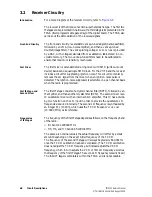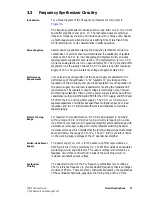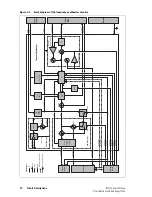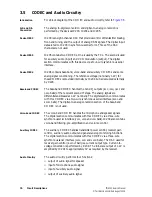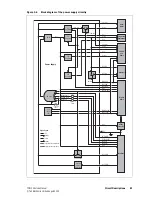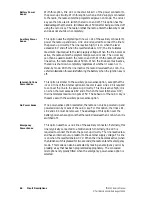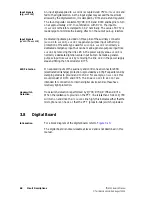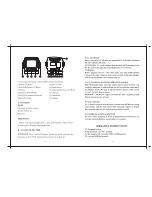
76
Circuit Descriptions
TM9100 Service Manual
© Tait Electronics Limited
August 2005
3.5
CODEC and Audio
Circuitry
Introduction
For a block diagram of the CODEC and audio circuitry, refer to
Figure 3.5
.
A/D and D/A
Conversion
The analog-to-digital conversion and digital-to-analog conversion is
performed by the devices IC203, IC204 and IC205.
Device IC203
IC203 is an eight-channel DAC that provides control of transmitter biasing,
front-end tuning, and the output of analog RSSI signals. The digital input
data are fed to IC203 in synchronous serial form. Three of the DAC
channels are not used.
Device IC205
IC205 contains two CODECs. One is used by the FCL. The second is used
for auxiliary audio (input) and VCO modulation (output). The digital
section communicates with this device via a four-wire synchronous serial
interface.
Device IC204
IC204 contains base-band, voice-band and auxiliary CODECs and some
analog signal conditioning. The reference voltage (nominally 1.2V) for
these CODECs is provided internally by IC204 but is decoupled externally
by C228.
Base-band CODEC
The base-band CODEC handles the I and Q outputs (
IRXP
,
IRXN
,
QRXP
and
QRXN
balls) of the receiver’s second IF stage. The analog signals are
differential and biased at 1.2 V nominally. The digital section communicates
with this CODEC via a two-wire synchronous serial interface (
BSDO
and
BSOFS
balls). The digital-to-analog conversion section of the base-band
CODEC is not used.
Voice-band CODEC
The voice-band CODEC handles the microphone and speaker signals.
The digital section communicates with this CODEC via a three-wire
synchronous serial interface (
VSFS
,
VSDO
and
VSDI
balls). IC204 also contains
voice-band filtering, pre-amplification and volume control.
Auxiliary CODEC
The auxiliary CODEC handles transmitter power control, receiver gain
control, auxiliary audio output and general analog monitoring functions.
The digital section communicates with this CODEC via a three-wire
synchronous serial interface (
ASFS
,
ASDI
and
ASDO
balls). The DAC used for
receiver gain control (
IDACOUT
ball) is a current output type. Current-to-
voltage conversion is performed by R238. The full-scale output of 1.2V is
amplified by IC201 to approximately 3V as required by the receiver.
Audio Circuitry
The audio circuitry performs four functions:
■
output of audio signal for speaker
■
input of microphone audio signal
■
input of auxiliary audio signal
■
output of auxiliary audio signal
Summary of Contents for TM9100
Page 1: ...TM9100 mobiles Service Manual MMA 00017 01 Issue 1 August 2005 ...
Page 4: ...4 TM9100 Service Manual Tait Electronics Limited August 2005 ...
Page 10: ...10 TM9100 Service Manual Tait Electronics Limited August 2005 ...
Page 22: ...22 Introduction TM9100 Service Manual Tait Electronics Limited August 2005 ...
Page 62: ...62 Description TM9100 Service Manual Tait Electronics Limited August 2005 ...
Page 96: ...96 TM9100 Service Manual Tait Electronics Limited August 2005 ...
Page 138: ...138 Disassembly and Reassembly TM9100 Service Manual Tait Electronics Limited August 2005 ...
Page 152: ...152 Servicing Procedures TM9100 Service Manual Tait Electronics Limited August 2005 ...
Page 168: ...168 Interface Fault Finding TM9100 Service Manual Tait Electronics Limited August 2005 ...
Page 244: ...244 Receiver Fault Finding TM9100 Service Manual Tait Electronics Limited August 2005 ...
Page 396: ...396 CODEC and Audio Fault Finding TM9100 Service Manual Tait Electronics Limited August 2005 ...
Page 420: ...420 Fault Finding of Control Head TM9100 Service Manual Tait Electronics Limited August 2005 ...
Page 426: ...426 Spare Parts TM9100 Service Manual Tait Electronics Limited August 2005 ...
Page 430: ...430 TM9100 Service Manual Tait Electronics Limited August 2005 ...
Page 444: ...444 TMAA04 05 Ignition Sense Kit TM9100 Service Manual Tait Electronics Limited August 2005 ...
Page 448: ...448 TMAA10 01 Desktop Microphone TM9100 Service Manual Tait Electronics Limited August 2005 ...







